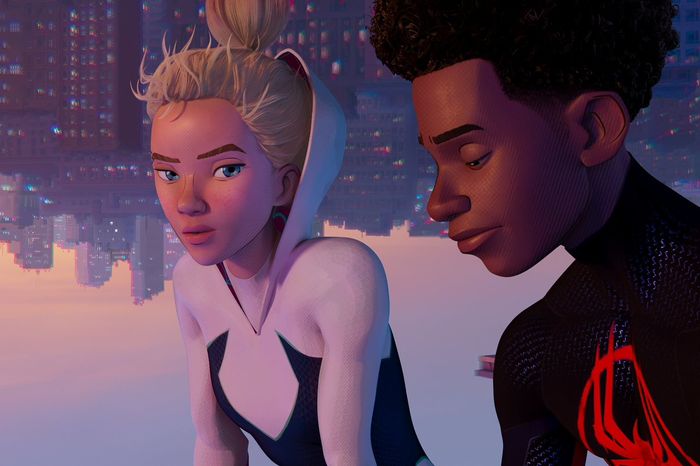
On January 23, 2024, Spider-Man: Across the Spider-Verse was nominated for a Best Animated Feature Film Oscar.
The Brooklyn belonging to Miles Morales (Shameik Moore), the 15-year-old hero of Spider-Man: Across the Spider-Verse, vibrates on the frequency of a comic book with a bustling cityscape with colors just slightly out of register and textures made of benday dots. But when the film, sequel to 2018’s Spider-Man: Into the Spider-Verse, begins, it picks up on Earth-65, a universe where Gwen Stacy (Hailee Steinfeld) was the one who got bitten by a radioactive spider and developed superpowers. Gwen, who plays drums in a punk band and has embraced the accidental undercut she received in the first film, lives in a New York where lines are blurrier and backgrounds are a soft wash of pinks and purples that suggest buildings — like a watercolor. When her dramatic exit from practice melts into a shot of her navigating a crowded subway train, it’s breathtaking — a distinctive visual language attuned to the inner life of a moody teenage girl with piercings and ballet shoes. Across the Spider-Verse looks incredible, even better than the groundbreaking first installment, but what’s truly impressive about it is how willing it is to entrust its storytelling to its animation.
The script (which producers Phil Lord and Christopher Miller wrote with David Callaham) is at turns clever, quippy, and heartfelt, but it’s the sheer joyous spectacle of the thing that knocks you over. Even exposition — Gwen’s background, the tragic fate of her world’s Peter Parker, her estrangement from her cop father — becomes worth marveling at. Those bursts of exposition are a running motif in the Spider-Verse films, which have each had a trio of directors (in this case, Joaquim Dos Santos, Kemp Powers, and Justin K. Thompson). As is all the rage right now, they take place in a kaleidoscopic array of alternate realities, each (with one notable exception) containing its own unique version of Spider-Man. While the first film made this into a witty bit, zipping through each new origin tale in a rapid-fire montage, the second movie raises a more existential question. Aside from web slinging and wall clinging, what are the qualities that make Spider-Man Spider-Man — whether it’s a blonde girl like Gwen, a bathrobe-wearing dad (like Jake Johnson’s Peter B. Parker), a pregnant Black woman on a motorcycle (Issa Rae’s Jessica Drew), an Indian teenager living in a Mumbai-Manhattan hybrid (Karan Soni’s Pavitr Prabhakar), a futuristic vampire (Oscar Isaac’s Miguel O’Hara), or, you know, someone made of Legos?
The answer seems to be shared personal tragedy, something Miles has been relatively spared — aside from the death of his uncle Aaron, who’d been hiding a villainous alter ego. Across the Spider-Verse pits its hero against a scientist turned inept criminal going by “the Spot” (Jason Schwartzman), who threatens to change that. But the bigger and more complex issue at hand is a secret organization of reality-hopping Spider-People who work together to maintain the structure of the multiverse. The film does a surprisingly good job of using ideas about comic-book canon to explore themes around parenting and the process of accepting that letting your child grow up means knowing they’re going to get hurt. In his clashes with his loving, frustrated parents (Brian Tyree Henry and Luna Lauren Vélez), who suspect Miles is keeping secrets from them, you see two people struggling to let go while aware of how the world treats young Black men like their son. Around three-quarters of the way through the film, though, you start to get the panicky feeling that it’s not going to make it to its big conclusion in time. Across the Spider-Verse no longer has “part one” appended to its title, but it’s very much half of a two-parter, and it’s better to be prepared for its plot’s crescendo toward a “to be continued” than to have this come as a surprise.
Look, if Dune and Fast X can leave off at the midpoints of their stories, there’s no reason Spider-Verse can’t pull it off, too, especially as this is a film that makes so much of its intimate moments and beats of downtime between the showier, kinetic set pieces. When, early on, Gwen figures out a way to cross universes to reunite with Miles, the two catch up while swinging through the streets, showing off the moves they’ve been practicing before taking a break atop the Williamsburgh Savings Bank Tower. As they hang upside down in the late-afternoon light, commiserating about their loneliness while the city stretches behind them in reverse, it’s not just romantic but a whole enveloping vibe. Across the Spider-Verse is thrilling as a work of art and animation, but the best compliment I can pay it is that it makes you want to pay a visit to all of its universes.
More From This Series
- Drive-Away Dolls Is Just Fizzy Enough
- Pedro Almodóvar’s Queer Cowboy Short Is Too Sumptuous for Its Own Good
- Civil War Isn’t the Movie You Think It Is





